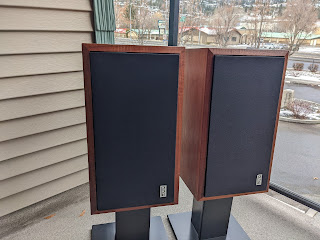If people have forgotten, Canadians make great speakers. Here are one of the original designs that came out during the early to mid 1970s that started to use the NRC anechoic chamber. PSB like many others Canadian brands (the most famous would be Energy with either Energy 22 line) had access to this wonderful camber to create/design their speakers.
These PSB Avante speakers are one of the originals that came out of the NRC during that time. From what I've been told, there is actually a pair in the museum. There are quite a bit of information about the NRC and the man behind the scene DR. Floyd Toole who help many Canadian brands make their mark on the audio scene. Potentially, it is possible Paul himself may have help built these speakers as Paul's father was a cabinet maker, and these cabs are well made with nice bevel fronts and very nice real wood veneer (walnut?).
What makes these speakers unique are the black silicone blobs on the woofer. Why? I guess paper cones had different consistencies back then and the added weight help create the "sound" that PSB wanted by adding mass. Newer PSB Avante had the same model woofer but, probably better consistency on the paper material.
The drivers aren't anything unique, they are all Philips drivers, it's the "tuning" on the woofers that make them interesting. I am pretty sure these speakers came out of a book/magazine by Philips on making speakers. Though these crossovers designs are different than the ones I could find from those PDF files I've read. Initially, they sounded alright, pretty flat with the peaky tweeter but, overall pleasant.
The crossover is quite simple, a couple resistors and air coil inductors with a single electrolytic 10uf capacitor, which was replaced with a brand new matched metallized polypropylene film capacitors.
Quite a bit of effort was done in recapping these speakers. The grills were quite difficult as the main adhesive was probably a RTV silicone and it was used in everything so I could only do the bare necessities with my basic tools. I did redo the grills with black speaker grills as the old ones were quite worn out and they do look nice.
So how do they sound? Initially, they were still a tad bright but, I guess with the burn-in time, they mellowed out. They sound a lot clearer than previously and when driven by my lovely recapped Pioneer SX-636, it quite the vintage eye candy. Surprisingly, it does have good amount of bass. the 8" long throw woofer isn't something to snuff at. They are pretty decent. Philips made good speaker drivers. Even the tweeter is pretty nice. They have good spatial breath, good separation and gives an illusion of a wide soundstage. Very pleasing to the ears.
Finally, I gave the cabinets a rub down of oil and they look lovely. While they were in decent shape to begin with, the oil helped give them a pop back to life.
Overall, I think many would be quite pleased with these speakers. I personally think an 8" woofer is quite adequate for most living spaces as it offers enough bass to provide a "full" sound. These are fairly neutral speakers and will probably work well with most type of amplification. I've driven them with my 200wpc power amp with no issues. They work well with music and movies. Big plus to Canadian speakers!
There are some specifications online but, they are of generation newer over these ones. But, I suspect they would be very similar as they too used Philips drivers.








